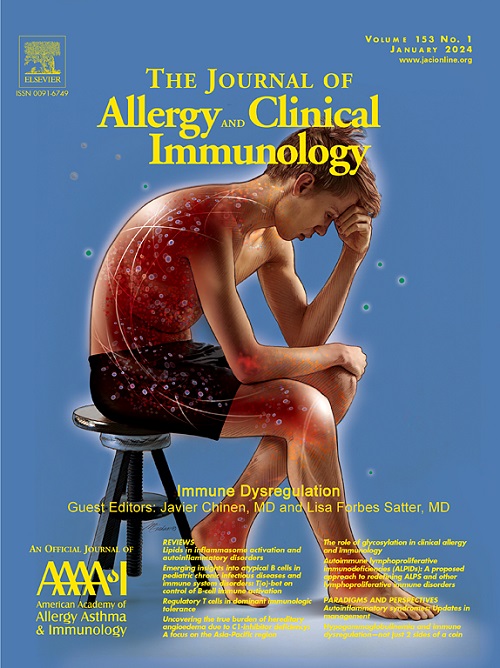The relationship between the early-life gastrointestinal microbiome and childhood nocturnal cough
IF 11.4
1区 医学
Q1 ALLERGY
引用次数: 0
Abstract
Background
Nocturnal cough affects approximately 1 in 3 children, can negatively affect child health, and is often attributable to asthma. The association of the gut microbiome with nocturnal cough has not been investigated.
Objective
We investigated the association between early-life gut microbiome composition and nocturnal cough overall and in the context of asthma.
Methods
Gut microbiota 1-month (neonate) and 6-month (infant) specimens from 512 children in the Wayne County, Health, Environment, Allergy, and Asthma Longitudinal Study were profiled using 16S ribosomal RNA V4 sequencing. Nocturnal cough (parental report) and asthma (parent-reported doctor’s diagnosis) were assessed at age 4 years. Microbiome regression-based kernel association tests (MiRKAT) were used to assess the relationship between gut microbiota composition and nocturnal cough overall and in the context of asthma. Operational taxonomic unit (OTU) associations were conducted using negative binomial regression, adjusting for multiple comparisons using the false discovery rate.
Results
Stool microbial composition differences during infancy were associated with nocturnal cough (weighted UniFrac P = .045); 78 OTUs were significantly associated with nocturnal cough overall (false discovery rate < 0.05); and 110 OTUs were significantly associated with nocturnal cough and differed by asthma status (interaction false discovery rate < 0.05), with a predominance of Lachnospiraceae genera Blautia and Dorea. Thirty-two OTU were identified as having both overall effects and differences by asthma status. Among OTUs with significant nocturnal cough-by-asthma interactions, 84 retained significance in children with asthma, with 45 exclusive to those with asthma (predominance of Bacteroidaceae genus Bacteroides and Lachnospiraceae genus Dorea).
Conclusion
Infantile gut microbiome development is associated with nocturnal cough and differed by asthma status by age 4 years. Further studies are needed to determine if the gut microbiome may provide additional information for the early identification of children at risk for nocturnal cough, with and without asthma.
早期胃肠道微生物群与儿童夜间咳嗽的关系。
夜间咳嗽影响大约三分之一的儿童,对儿童健康有负面影响,通常可归因于哮喘。肠道菌群与夜间咳嗽的关系尚未被调查。目的探讨儿童早期肠道菌群组成与夜间咳嗽的关系。方法采用16S rRNA V4测序方法对美国韦恩县健康、环境、过敏和哮喘纵向研究中心512名儿童1个月(新生儿)和6个月(婴儿)的肠道微生物群进行分析。在4岁时评估夜间咳嗽(父母报告)和哮喘(父母报告医生诊断)。使用基于微生物组回归的核心关联试验来评估肠道微生物群组成与总体和哮喘患者夜间咳嗽之间的关系。使用负二项回归进行操作分类单位(OTU)关联,并使用错误发现率(FDR)对多重比较进行调整。结果婴幼儿粪便微生物组成差异与夜间咳嗽相关(加权Unifrac p=0.045)。78例OTUs与夜间咳嗽总体显著相关(FDR<0.05)。110例OTU与夜间咳嗽有显著相关性,且与哮喘状态存在差异(相互作用FDR<0.05),其中毛缕菌科Blautia和Dorea占优势。32例OTU对夜间咳嗽既有总体影响,又有哮喘状态差异。在夜间咳嗽与哮喘相互作用显著的OTUs中,84例在哮喘儿童中保持显著性,其中45例仅存在于哮喘儿童中(以拟杆菌科拟杆菌科和毛缕菌科为主)。结论婴幼儿肠道菌群发育与夜间咳嗽有关,且随4岁前哮喘状态的不同而不同。需要进一步的研究来确定肠道微生物组是否可以为早期识别有或无哮喘夜间咳嗽风险的儿童提供额外的信息。
本文章由计算机程序翻译,如有差异,请以英文原文为准。
求助全文
约1分钟内获得全文
求助全文
来源期刊
CiteScore
25.90
自引率
7.70%
发文量
1302
审稿时长
38 days
期刊介绍:
The Journal of Allergy and Clinical Immunology is a prestigious publication that features groundbreaking research in the fields of Allergy, Asthma, and Immunology. This influential journal publishes high-impact research papers that explore various topics, including asthma, food allergy, allergic rhinitis, atopic dermatitis, primary immune deficiencies, occupational and environmental allergy, and other allergic and immunologic diseases. The articles not only report on clinical trials and mechanistic studies but also provide insights into novel therapies, underlying mechanisms, and important discoveries that contribute to our understanding of these diseases. By sharing this valuable information, the journal aims to enhance the diagnosis and management of patients in the future.

 求助内容:
求助内容: 应助结果提醒方式:
应助结果提醒方式:


